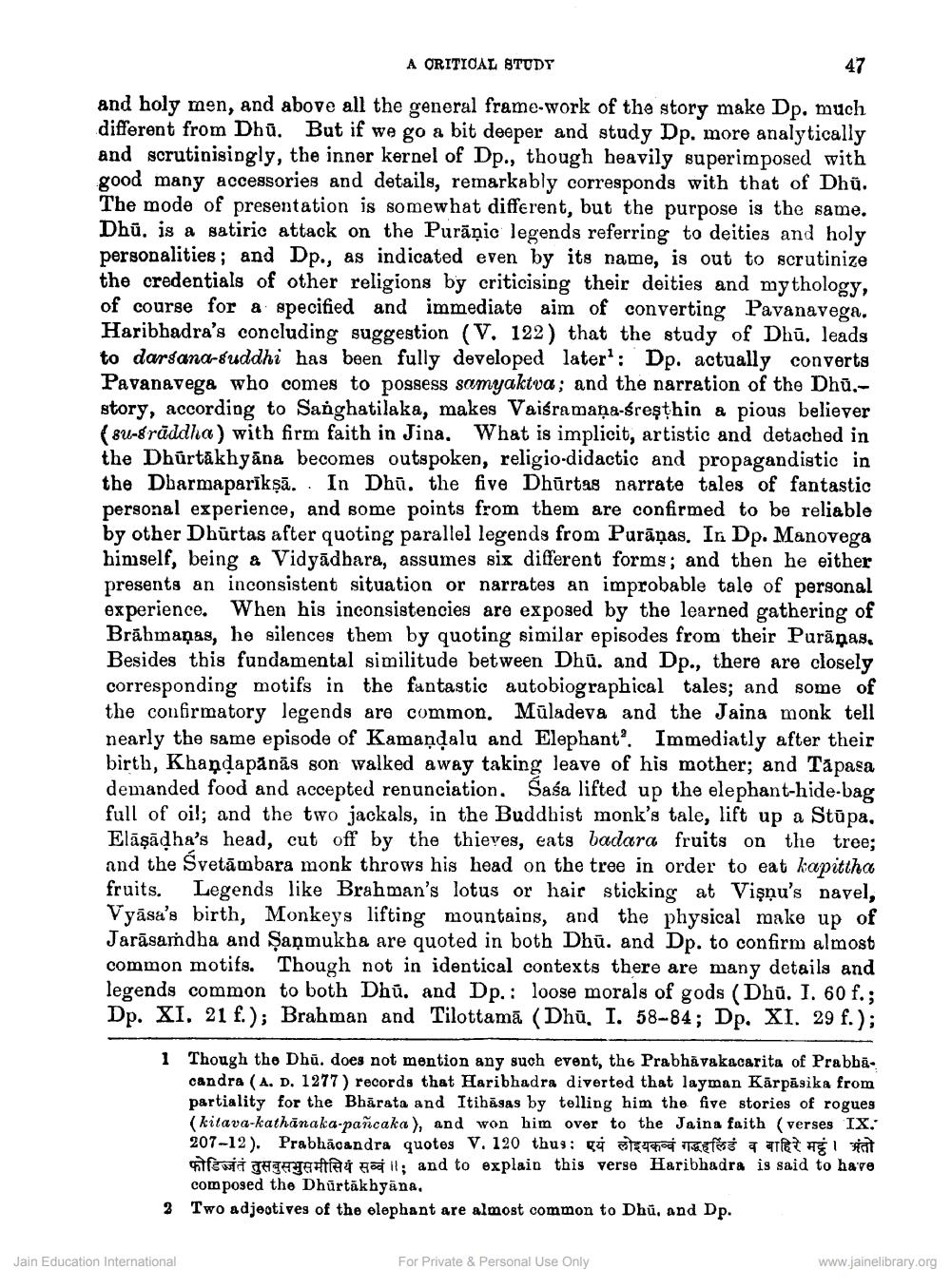________________
A CRITICAL STUDY
and holy men, and above all the general frame-work of the story make Dp, much different from Dhū. But if we go a bit deeper and study Dp, more analytically and scrutinisingly, the inner kernel of Dp., though heavily superimposed with good many accessories and details, remarkably corresponds with that of Dhû. The mode of presentation is somewhat different, but the purpose is the same. Dhû. is a satiric attack on the Purāņic legends referring to deities and holy personalities; and Dp., as indicated even by its name, is out to scrutinize the credentials of other religions by criticising their deities and mythology, of course for a specified and immediate aim of converting Pavanavega. Haribhadra's concluding suggestion (V. 122) that the study of Dhū. leads to darsana-ruddhi has been fully developed later: Dp. actually converts Pavanavega who comes to possess samyaktva; and the narration of the Dhū,story, according to Sanghatilaka, makes Vaiśramaņa-śreşthin a pious believer (84-8rāddha) with firm faith in Jina. What is implicit, artistic and detached in the Dhurtākhyāna becomes outspoken, religio-didactic and propagandistic in the Dbarmaparīkņā. In Dhū. the five Dhūrtas narrate tales of fantastic personal experience, and some points from them are confirmed to be reliable by other Dhūrtas after quoting parallel legends from Parāņas. In Dp. Manovega himself, being a Vidyādbara, assumes six different forms; and then he either presents an inconsistent situation or narrates an improbable tale of personal experience. When his inconsistencies are exposed by the learned gathering of Brāhmaṇas, he silences them by quoting similar episodes from their Purāņas. Besides this fundamental similitude between Dhū. and Dp., there are closely corresponding motifs in the fantastic autobiographical tales; and some of the confirmatory legends are common. Mūladeva and the Jaina monk tell nearly the same episode of Kamandalu and Elephant'. Immediatly after their birth, Khandapānās son walked away taking leave of his mother; and Tapasa demanded food and accepted renunciation. Saśa lifted up the elephant-hide-bag full of oil; and the two jackals, in the Buddhist monk's tale, lift up a Stūpa, Elāşādha's head, cut off by the thieves, eats badara fruits on the tree; and the Svetāmbara monk throws his head on the tree in order to eat kapittha fruits. Legends like Brahman's lotus or hair sticking at Vişnu's navel, Vyāsa's birth, Monkeys lifting mountains, and the physical make up of Jarāsaņdha and Şaņmukha are quoted in both Dhū. and Dp. to confirm almost common motifs. Though not in identical contexts there are many details and legends common to both Dhū. and Dp.: loose morals of gods (Dhū. I. 60 f.; Dp. XI. 21 f.); Brahman and Tilottamā (Dhū. I. 58-84; Dp. XI. 29 f.);
1 Though the Dhū. does not mention any such event, the Prabhāvakacarita of Prabbā.
candra (A. D. 1277) records that Haribhadra diverted that layman Kārpāsika from partiality for the Bhārata and Itibāsas by telling him the five stories of rogues (kitava-kathānaka-pañcaka), and won him over to the Jaina faith (verses IX. 207-12). Prabhācandra quotes V. 120 thus: i 40 Tatot a at aglat
cajá The au gorill; and to explain this verse Haribhadra is said to have composed the Dhurtākhyāna. 3 Two adjectives of the elephant are almost common to Dhū, and Dp.
Jain Education International
For Private & Personal Use Only
www.jainelibrary.org




